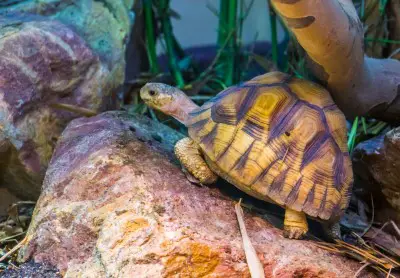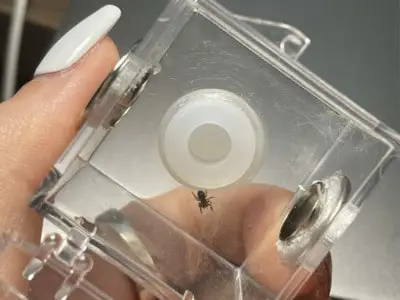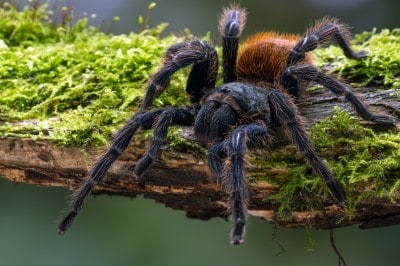Wild tarantulas have various options for their diet since they can eat most of the weak and tiny animals they come across. However, the case may be different when in captivity because they only eat their owners’ food. Therefore, you may wish to know whether it is safe to feed them mice.
Tarantulas, especially giant species like the Bird Eaters, can eat mice. It is safe to provide pinkies or recently-killed meals and not live prey. Mice tend to bite and scratch their predators and can seriously injure your pet. Therefore advocate for frozen pinkies or mice from the pet stores.
Every pet parent wants their tarantula to eat healthy and safe food. Therefore, you need to know what is good and bad for your tarantula to give it the best. Read on for more information on whether tarantulas can eat mice and how you can serve it to them.

Do Tarantulas Eat Mice?
Some tarantula owners love experimenting on different foods when feeding their pets. Since you want the best for your tarantula, it is essential to provide only the harmless and most nutritious meals. Considering tarantulas obtain calcium and proteins from live food, we aim to establish whether it is okay to feed them mice.
Your tarantula can eat mice, including pinkies, adult mice, and any other small rodent. A tarantula can attack and feed on a live mouse as long as it is smaller; hence, the prey will not put up a fight or harm the spider in the process. Your pet will likely kill the rodent if it is smaller or the same size.
However, it would be best if you were cautious because some rodents can seriously harm your tarantula. Therefore, we advise that you provide such meals to giant tarantulas since they are more aggressive and can easily overpower the rodents. Also, only feed them frozen mice after thawing to prevent the hard ice cover from hurting their fungs.
Giant tarantulas like the curly-haired, Bird Eaters, and the King Baboon species can comfortably eat mice. They are great hunters when in the wild and can attack a live mouse when they cross paths. You will also find them eating a dead mouse as long as it is still warm and fresh.
They will devour most of it and leave the rest of the corpse untouched and won’t get back to it when it gets stale. Usually, live meals are highly nutritious for spiders, explaining why most owners are keen on an insect diet for their pets. Others also find the pinky mice and small rodents an excellent protein source to help their tarantulas grow, especially after molting or laying eggs.
Is It a Good Idea To Feed Live Mice To Your Tarantula?
Your pet’s safety should always come first. Although some tarantulas can attack and eat mice while in the wild, some situations may be a bad idea to provide mice, even as a diet supplement.
Live mice pose a grave danger to tarantulas, regardless of their size. The best way to go is to use pinkies or recently killed adult mice. The prey will likely fight to survive, and your spider may sustain injuries. Besides, it isn’t kind for the mouse to be locked up and left for the spider to devour.
It would help if you also were cautious because live mice host many diseases, which may transfer to your pet. Also, be prepared to clean up after your tarantula is done because they don’t consume the whole meal, and the leftover bits will rot and smell.
We are firmly against feeding live mice to your tarantula. It isn’t a good idea, and you may be risking your pet’s life in the process. Avoid them, especially if your tarantula isn’t a giant species like the bird eaters who are skilled hunters and pretty aggressive. Some spiders are too tiny to feed on rodents and would instead stick to insects for their safety. Mice are known to bite and scratch their predators unless they are sickly or old. The aftermath can be mild or severe and risky to your pet.
A frozen mouse is your safest bet because it isn’t likely to carry any diseases, and you will be confident that your pet is secure. Most importantly, it is best to provide mice when your pet is old enough because otherwise, the meal may be too overwhelming for them. Other owners also feed their pets rodents immediately after or before molting.
The best way to go is to wait for around a week because their fangs are still brittle, and eating such a rigid meal may be damaging or strenuous. Lastly, avoid the high-protein meal if your tarantula is overweight because it will only escalate the situation.
The Best Way To Feed Mice To Tarantulas
Mice typically pose a threat to your pet tarantula; hence, you need to be cautious when providing them. The mice bones are loaded with calcium, which is vital for your buddy’s health, but you need to serve them as treats, preferably once or twice a week. The following are other essential precautions that you need to consider.
- Use Tongs To Feed the Tarantulas
Spiders bite, making it risky to feed them with your bare hands. Although some are not venomous, they can still give a painful sting. Therefore, it is wise to use forceps when feeding your pet. Besides, it is hygienic compared to dropping a dead mouse into their cage. They tend to leave a large portion uneaten, and unless you clean everything up, these bits will eventually decompose and emit a pungent smell.
- Using Food Bowls
Bowls are a great alternative to tong feeding. The leftovers usually remain in the bowl, making it easier for you to clean up afterward. On the contrary, if your tarantula is hyperactive and aggressive, it can ransack the bowl when eating and spill bits all over the enclosure. You can only use tongs to attract their attention or when your pet is the gentle and shy type. The bowls will save you extra cleaning that you would otherwise do when you place the meal on the substrate.
- Collect the Carcass Remains
Your tarantula may not always eat straight from the bowl. You can keep an eye on food particles in the cage since they can scatter the remains. Such leftovers can cause infections to your pet which may also turn out fatal. Additionally, you need to thoroughly clean the enclosure and substrate since there are high chances of blood spills. If you leave them out, the fluids can cause an odor that may infiltrate into the whole house, especially during hot days.
- Warm the Meal Before Serving
Like other pets, each tarantula has its preference; some will prefer cold meals while others would opt for warm ones. When you serve the dead mouse while warm, the tarantula will assume that it is a freshly dispatched rodent. You could place the prey in warm water for a while or defrost it if you previously froze it.
- Unfreeze The Mouse
Serving a cold mouse to your pet tarantula is detrimental to their teeth; therefore, it is best to thaw it to make it soft and warm. You can place the frozen mouse in an open-air or hang it in a polythene bag in warm water. De-freezing is ideal because you will be de-icing the carcass and consequently warming it, saving you the extra hassle before serving.
- Consider Smaller Mice
It is always advisable to provide dead mice, but you can confidently offer live pinkies to keep giant and aggressive tarantulas. Ensure that the prey is small, perhaps half the size of the spider’s leg span. You can train them with smaller rodents and upgrade to mature mice as they gain more experience.
Wrap Up
You can feed mice to your tarantula as long as you are cautious and follow the guidelines as we have advised. Your best bet is the pinkies or recently killed rodents since it is safe for your pet and kinder to the prey. Live mice tend to put up a spirited fight when attacked and can leave your tarantula hurt. Only giant species like the Bird Eaters can comfortably devour large mice.
It is important to note that pinkies are rich in proteins and can cause obesity and other complications if you provide them frequently. Therefore, you can feed it to your tarantula as a treat instead or during the molting period or when laying eggs as a protein source.
Read more:








